- News
- Reviews
- Bikes
- Accessories
- Accessories - misc
- Computer mounts
- Bags
- Bar ends
- Bike bags & cases
- Bottle cages
- Bottles
- Cameras
- Car racks
- Child seats
- Computers
- Glasses
- GPS units
- Helmets
- Lights - front
- Lights - rear
- Lights - sets
- Locks
- Mirrors
- Mudguards
- Racks
- Pumps & CO2 inflators
- Puncture kits
- Reflectives
- Smart watches
- Stands and racks
- Trailers
- Clothing
- Components
- Bar tape & grips
- Bottom brackets
- Brake & gear cables
- Brake & STI levers
- Brake pads & spares
- Brakes
- Cassettes & freewheels
- Chains
- Chainsets & chainrings
- Derailleurs - front
- Derailleurs - rear
- Forks
- Gear levers & shifters
- Groupsets
- Handlebars & extensions
- Headsets
- Hubs
- Inner tubes
- Pedals
- Quick releases & skewers
- Saddles
- Seatposts
- Stems
- Wheels
- Tyres
- Health, fitness and nutrition
- Tools and workshop
- Miscellaneous
- Tubeless valves
- Buyers Guides
- Features
- Forum
- Recommends
- Podcast
review
 2023 Reserve Fillmore valves
2023 Reserve Fillmore valves£34.99
VERDICT:
Novel design and technical ingenuity at its best – these valves are undeniably expensive but commensurately brilliant
High flow rate
Easy micro-adjust/deflate control
Considerably stronger than Presta valves
No clogging
Beautifully made, exemplary machining
Sizes available for 18-68mm rim depths
Relative to competing products, they're expensive
Lack of colours
Weight:
14g
Contact:

This product has been selected to feature in road.cc recommends. That means it's not just scored well, but we think it stands out as special. Go to road.cc recommends
At road.cc every product is thoroughly tested for as long as it takes to get a proper insight into how well it works. Our reviewers are experienced cyclists that we trust to be objective. While we strive to ensure that opinions expressed are backed up by facts, reviews are by their nature an informed opinion, not a definitive verdict. We don't intentionally try to break anything (except locks) but we do try to look for weak points in any design. The overall score is not just an average of the other scores: it reflects both a product's function and value – with value determined by how a product compares with items of similar spec, quality, and price.
What the road.cc scores meanGood scores are more common than bad, because fortunately good products are more common than bad.
- Exceptional
- Excellent
- Very Good
- Good
- Quite good
- Average
- Not so good
- Poor
- Bad
- Appalling
Reserve's Fillmore valves enter a market saturated by both premium and cheap options – we've never had more choice. Unlike the majority of tubeless valves in circulation (no pun intended), the Reserves are not strictly Prestas, they're a Presta-compatible reimagining of a bike valve that prioritises high flow rate and prevents clogs. And they succeed. Wildly. It was surprising to be quite so excited by valves, but they're ingenious, and work brilliantly.
For the last five weeks, admittedly a brief service so far, they've been flawless. No leaks, no clogs, no mess, no loosening, and pressure has held. Installation was easy, and they've simplified tyre changes and sealant top-ups. They come in three different sizes to accommodate rim depths from 18mm up to 68mm, and, as Henry Ford put it, 'any colour so long as it's black' (though coloured anodised caps are now available). The only negative, really, is the price: at £34.50 they're a tenner more than 76 Projects', and £7.50 more than Muc-Off's.
Modern sealants are designed to seal holes about the same diameter as a Presta valve. Little wonder then that they clog with such alacrity. If you've yet to embrace tubeless, these could be the valves to change your mind.
> 9 things they don’t tell you about tubeless tyres
The Reserves went onto my 'everyday' gravel bike, which also serves as my 'as-needed' commuter, so they got a bit of high rotational speed from road riding, and some bouncing around on soggy bridleways.
Reserve claims three times the airflow over a regular Presta valve, which seemed believable in my back-to-back testing against the Tune tubeless valves they replaced. With a vigorous press on my track pump, it certainly felt like more air went in faster, and my GravelKings leapt enthusiastically onto the rim bead without extra coaxing or the pressurised tank on my Topeak Joe Blow Booster.
Topping up the sealant was similarly painless, with the gloop being pressed more easily though the wider valve. And, of course, there's no core to remove. Simply wipe the tip, add a little more air, then the cap and you're done.
Reserve says it uses the standard Presta interface so all pumps should work. They'll also work with tyre inserts like CushCores if you run those.
So far so good. But would they hold or would they leak? They held, perfectly. I attribute this to some very clever design. Reserve has removed the core and maintained a wide stem for high volume through-put. Additionally, it's moved the sealing mechanism (a poppet) to the bottom of the valve on the inside of the rim. The poppet (an O-ring on the tapered head of a steel rod) is held closed both by the positive pressure inside the tyre pushing it shut, but also by the valve cap. The cap screws down onto the valve stem AND onto the other end of the steel rod that runs the length of the valve. Screwing down the cap therefore also pulls the poppet up and shut. You can see the separate threading on the rod.
Effectively, the poppet is both pushed shut by the air pressure in the tyre, and pulled shut by the valve cap. This is more secure than a Presta valve, and results in a tight closure with no discernible leakage. Hats off to this engineering.
The Presta valve, though ubiquitous, has remained largely unchanged in the last century, and the Reserves demonstrate how poorly suited Prestas are to the demands of tubeless and sealants. The Reserves are that rare combination of 'better' and 'simpler'; without a core to remove, they're less fiddly, less messy and way more durable. In fact, it was only when trying these that I realised how I had just accepted bent brass Presta valves as a matter of course, particularly long-stemmed valves.
When it comes to adjusting the pressure, unscrewing the cap a turn or two allows you to press down on it to 'micro-adjust' the pressure, letting out small, controlled blasts. Not vastly different from a Presta, but the process feels very much more intentional.
The other striking quality about the valve is, well, its quality. It's a surprisingly tactile thing; it screams premium, and the finishing is exemplary. The machined threading feels very fine, and both the cap and locknut spin effortlessly and rapidly. I've never ridden a set of Reserve wheels, but the engineering of these valves makes me want to.
It's been very cold and very wet recently, but the Reserves have behaved and performed flawlessly. It's really that simple. And they've won near universal praise from anyone who's tried them.
Value and conclusion
The only (again a near-universal) detraction is the issue of their price and value. Even in a world of four and five figure bikes, £35-£45 (depending on size) for a pair of valves is not nothing, especially when reasonable valves can be had for a quarter of the price, nice valves for half the price, and next-best offerings for two-thirds of the price.
Stu really liked the Muc-Off Tubeless Presta valves he tested in 2019 when they were £22.50, although the 'all new' V2s are £27, and Chad thought the 76 Projects Hi Flow No Clog Tubeless Valves were excellent, and they're cheaper at £24.50 a pair. I haven't tried those, but going by Chad's review I'd say the Fillmores are a lot simpler to fit, simpler to 'close', don't have any kind of core to clog, are a wider design so will (likely) allow more/faster air through-put, and seemingly have better Presta/pump compatibility.
The design of the Fillmores is really stand-out for its novelty and simplicity, and they're still going strong.
In the long-term, despite the high cost of purchase, with a lifetime guarantee backing these up, the point at which they pay for themselves becomes a matter of when, not if. They're expensive for valves to be sure, but I'd say they're the best valves you can buy.
Verdict
Novel design and technical ingenuity at its best – these valves are undeniably expensive but commensurately brilliant
road.cc test report
Make and model: Reserve Fillmore Valves
Size tested: 30-48mm
Tell us what the product is for and who it's aimed at. What do the manufacturers say about it? How does that compare to your own feelings about it?
The Fillmore valves are aimed at road and gravel riders who want to run tubeless tyres, but find the faff of sealants, the inevitable mess in fitting new tyres and topping up sealant in already seated tyres to be a major detractor. Reserve claims its valves have a high flow rate, and don't clog. My experience has been nothing short of exemplary, with no clogs, no mess and no issues seating or sealing.
From Reserve: "The patented Fillmore valve represents a game-changing leap forward in technology, with a high-flow design that eases tubeless set up and eliminates the traditional, delicate, clog-inciting valve core of yesteryear."
Tell us some more about the technical aspects of the product?
The manufacturing quality is phenomenal, and they feel (deservedly so) like the most expensive valves you've ever held. The machining, particularly, is of the highest calibre. It is also vastly stronger (a steel rod running through it) than the frequently bent brass in Presta valves.
From distributor Jungle Products:
FEATURES
High Flow: 3X air flow makes seating tires a snap
No Clog: Eliminates clogging and busts through dry sealant
Micro-Adjust: Airs down to the perfectly dialed tire pressure
Direct-Inject: Coreless design for no-fuss injection of sealant
COMPATIBILITY
50mm Fillmore Valve - Rim Depth - 18mm to 28mm
NO HASSLES
Lifetime Guarantee!
EASY INSTALLATION!
Installing Fillmore Valves is just as easy as installing Presta or Schrader valves on your wheels.
1. Remove your tire from your tubeless rim. Dispose of sealant and wipe rim clean
2. Unscrew and remove existing valve
3. Unscrew Fillmore valve cap completely and remove nut from existing valve
4. Push Fillmore valve through valve opening in rim
5. Thread valve nut onto body of Fillmore valve
6. Mount tire onto rim
7. Use fine tipped sealant bottle or injector to add sealant through Fillmore
8. Attach pump and inflate tire to manufacturer specification
9. Screw Fillmore valve cap over valve end and secure
10. Go ride
Rate the product for quality of construction:
10/10
There's a simplicity and clever design here that really caught me by surprise. It's fundamentally a simpler design than a Presta valve: a single opening at the bottom that is both pushed shut by the pressure in the tyre, and pulled shut by screwing the cap onto the valve stem. Great idea, executed precisely.
Rate the product for performance:
9/10
So far, no clogs, and the higher flow rate allowed all tyres I tried to seat with merely some vigorous efforts through a track pump.
Rate the product for durability:
9/10
So far so good. They're considerably stronger than Presta valves, and are backed by a "lifetime warranty".
Rate the product for weight (if applicable)
8/10
The high-grade 7000 series aluminium and internal steel rod are beautifully machined to minimal proportions; nonetheless, steel is heavier than brass, and the wider stem uses more metal than the skinny Presta stems. Still, for 5.5g each, even the most ardent weight-weenie couldn't object.
Rate the product for value:
5/10
Really, the only variable in deciding whether to purchase these or not is the price. These are more expensive than any other valve I've used, but at some point, when they've outlasted the cheap and disposable Prestas, and more expensive also-rans, they will pay for themselves. They're investments that will pay off in the long-term, and make the interim process less messy.
Tell us how the product performed overall when used for its designed purpose
I sought out their flaws, but was hard-pressed to find anything! They're well made, cleverly designed, do their job better than anything else I've ever used, and are the new high-bar.
Tell us what you particularly liked about the product
Simple design, beautifully executed and precisely machined.
Tell us what you particularly disliked about the product
Nothing. You can now get the caps in a few different colours, but the 'competing' Muc-Off valves come in 20 different anodised colours.
How does the price compare to that of similar products in the market, including ones recently tested on road.cc?
They're vastly more expensive than 'disposable' Presta valves, and a third more expensive than anything else.
Did you enjoy using the product? Very much, yes.
Would you consider buying the product? I would more than consider it, I will now not buy any other brand for a tubeless tyre (until something better comes along...).
Would you recommend the product to a friend? Whole-heartedly
Use this box to explain your overall score
At the moment, the only thing holding this valve back from all-conquering status is the price. If Reserve can lean on economies of scale, or find other ways to bring down the price, this really is the gold standard in performance. They simplified and made less arduous the tasks of both fitting a new tubeless tyre and pumping new sealant straight through the valve into an already seated tyre.
About the tester
Age: 45
I usually ride: Custom titanium gravel My best bike is:
I've been riding for: Over 20 years I ride: Most days I would class myself as: Experienced
I regularly do the following types of riding: commuting, touring, club rides, sportives, general fitness riding, fixed/singlespeed, mtb,
Tom is features and tech writer who's been writing and riding for over 20 years, and has had misadventures on almost every conceivable bike. From single-speeds, to aero race-bikes, gravel bikes, ebikes and mountain bikes, he's a big fan of almost everything that rolls on two wheels.
Latest Comments
- David9694 11 min 24 sec ago
More concern about illegal parking in Trowbridge...
- David9694 15 min 32 sec ago
Bradford-on-Avon police chase ends in crash https://www.wiltshiretimes.co.uk/news/24914082.bradford-on-avon-police-c...
- mdavidford 25 min 31 sec ago
Not if you count the binary ones.
- Joe Totale 39 min 26 sec ago
Indeed. For example as this review highlights, this case doesn't work for larger smartphones whilst a sandwich bag will fit all modern phones so in...
- JMcL_Ireland 58 min 40 sec ago
It looks like a lot of watch for the money, but there doesn't seem to be any way to sync to Garmin Connect other than using something like Tapiriik...
- OldRidgeback 1 hour 6 min ago
That's an appalling case and an extremely lenient sentence given it sounds very like a racially aggravated assault. I assume the attacker is an...
- eburtthebike 1 hour 26 min ago
"The strength of community feeling around this was very vocal........"...
- BPhillips 2 hours 46 min ago
Car paint is a good idea, but my previous attempts haven't been good, so I'll leave it to someone that knows what they're doing!
- mdavidford 2 hours 46 min ago
Maybe someone stuck all their stuff to the ceiling.
- super_davo 3 hours 25 min ago
Jeez you're all cynical... ...










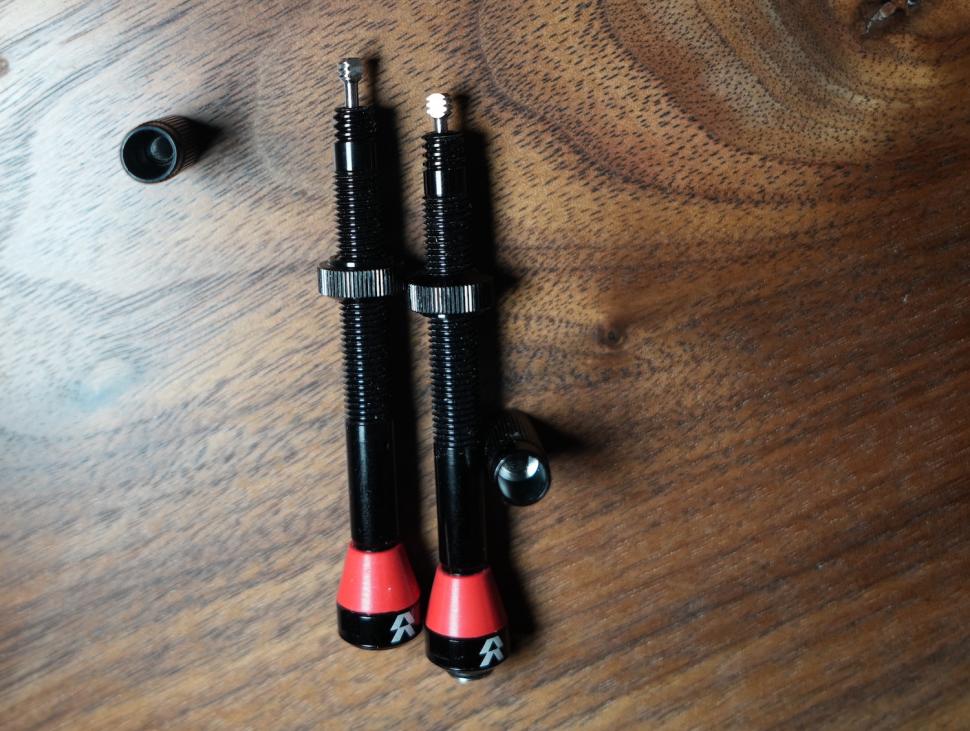
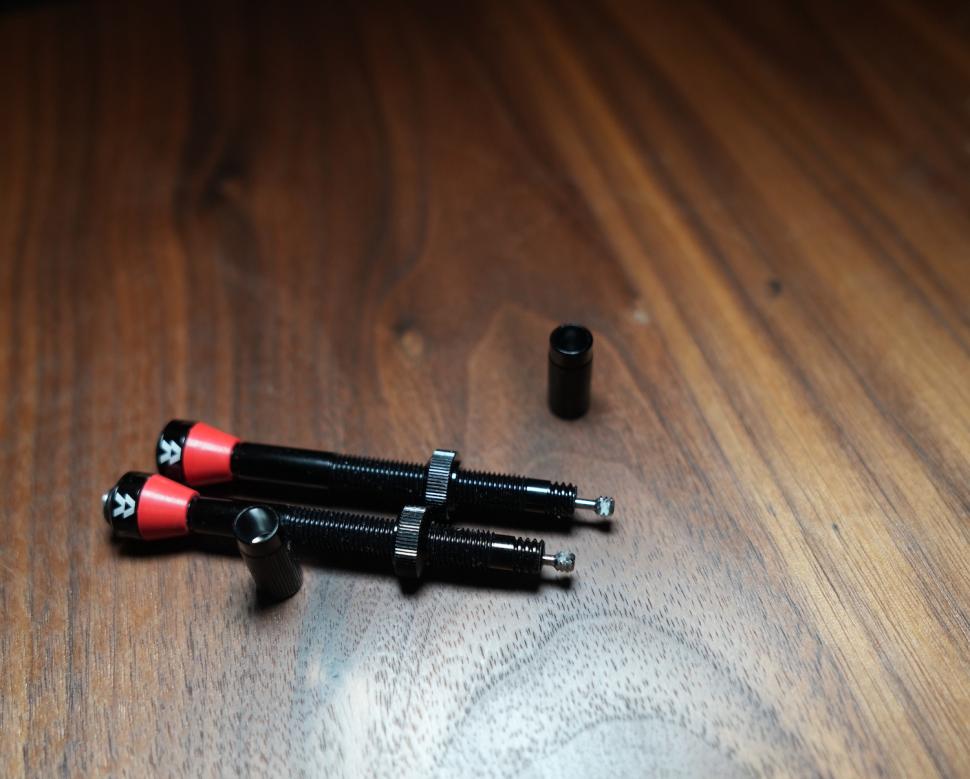

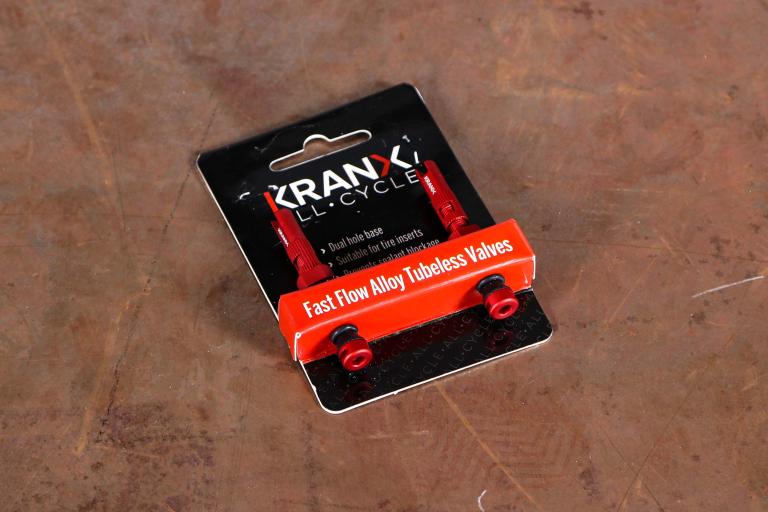
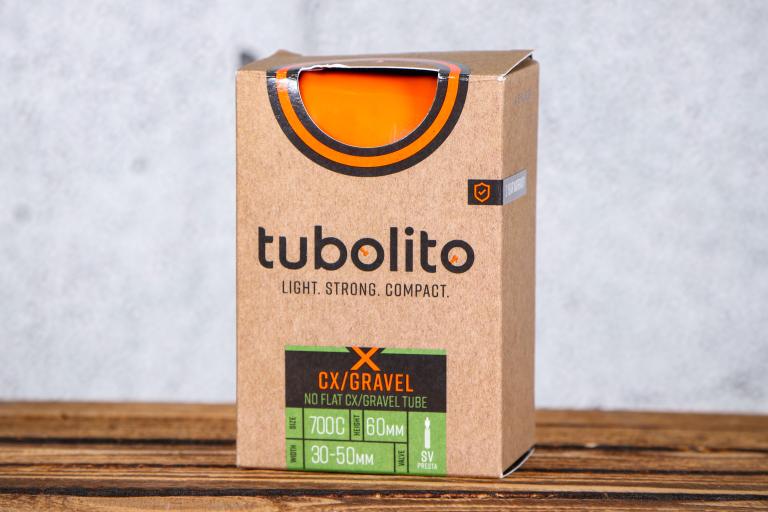
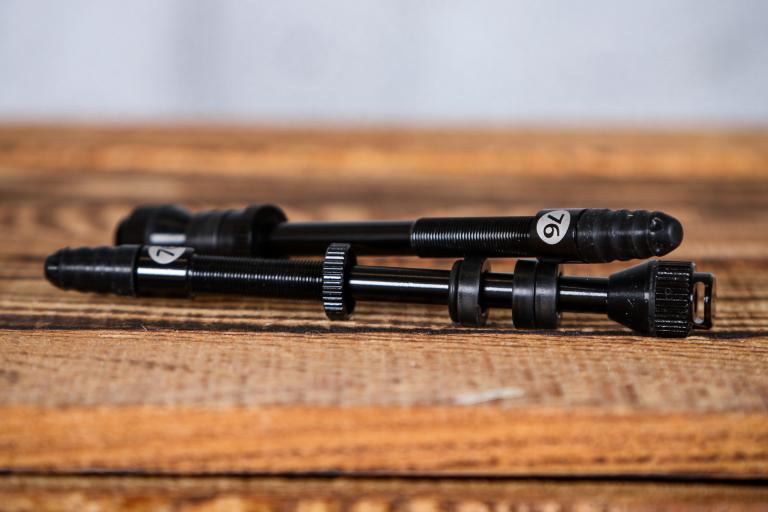
Add new comment
4 comments
waiting for mine to arrive
At last the real world review I have been really waiting for.
I'm running them (well, on the rear tire now, had to pop in a tube at the front after an unsealable leak) and for sure, they're good valves.
Can't quantify the airflow advantage but pumping up a tire is certainly easier than with a standard presta. Seating a bead using an airshot is easy as pie and you can set up the tire in one go, no more fiddling with valve cores. They seal up very easily against the rim, no airloss at all. When handling them you can feel that it's a quality, well-designed and machined component.
One caveat: you can squirt sealant in through the valve in most, but not all, cases. E.g. Stans race day is a definite no go, the only way there is to loosen up part of the bead and pour it in directly. Also: they don't work loose but take care not to lose a cap -e.g. during a roadside repair- or the valve becomes essentially worthless.
The price is what it is, I can live with it and if you can too then know that the valve itself is god quality and you're not throwing away your hard-earned.
I use a sealant injector with a threaded hose - Stan's Injector, but I'm sure there are others - so it screws onto the valve and then I can force the sealant in.